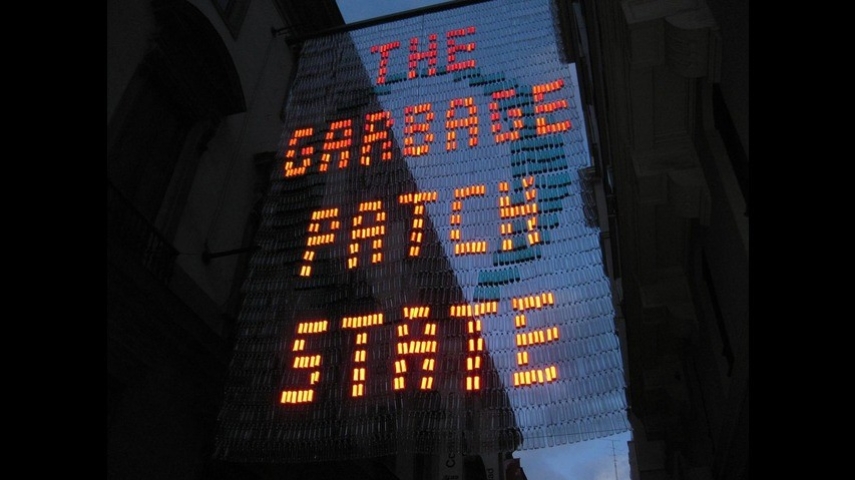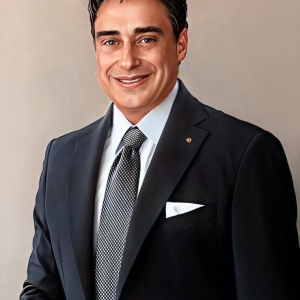
“I alone cannot change the world, but I can cast a stone across the waters to create many ripples.” Mother Teresa
As the President of IASC, I constantly work to maximize those ripples. Recently, I was honored to receive “The Garbage Patch State” Passport, recognition of my unwavering support for the “Wasteland Project,” a profound and transformative use of art. Its mission is to evoke a deep understanding of the imminent peril posed by water pollution on our planet. Through this remarkable artwork, the public is exposed to the staggering reality of vast assemblages of plastic material in our oceans, ominously known as the Garbage Patch. It’s a dire environmental crisis often overlooked, but the artist behind this initiative is determined to sound the alarm and inspire action.
Let me introduce you to the extraordinary architect and artist, Maria Cristina Finucci. Her artistic journey began at a tender age, embracing painting, sculpture, architecture, design, video art, and film. Her very first exhibition, titled “Paradigms,” graced the halls of the Lucca Museum in Italy back in 2010. Throughout her illustrious career as an architect, she called diverse cities like Moscow, New York, Paris, Brussels, and Madrid home. Her innovative projects have been celebrated in numerous magazines and books, while her furniture designs have earned a place at the prestigious Salone del Mobile in Milan.
In 2013, a pivotal year, she embarked on her monumental artistic cycle called “Wasteland.” This transmedia project confronts the colossal islands of plastic garbage sprawled across our oceans, with the largest, the Pacific Trash Vortex, taking center stage. Her audacious idea was to establish this plastic “territory” as a federal state, and in doing so, she’s thrown a spotlight on a crisis that has largely remained invisible to the world. As Maria Cristina poignantly puts it, “I envisioned creating a State out of these islands entirely composed of plastic waste, spanning approximately 16 million square kilometers, nearly the size of the Iberian Peninsula. These ‘islands’ are ignored by public opinion primarily because they exist far from our immediate view.
And she couldn’t be more right about the impending threat to humanity. Microplastics, as she asserts, are hormone disruptors, stealthily infiltrating our food chain and poisoning our oceans. It’s an insidious peril that’s inching closer to our shores every day.
In April 2013, with the General Director of UNESCO and other dignitaries by her side, Maria Cristina Finucci planted the flag of her new State and delivered an impassioned inauguration speech for the Garbage Patch State. It marked the official commencement of the Wasteland cycle, and during the Venice Biennale of 2013, the Garbage Patch State earned its own pavilion in the courtyard of Ca’ Foscari University. Thousands of colorful plastic cups seemed to defy gravity as they clung to the walls surrounding this ancient institution, as if yearning to reach the nearby lagoon.
2014 saw the Garbage Patch State make its presence felt at the international art fair, ARCO, in Madrid. The inaugural National Day of the Garbage Patch State witnessed the artist inaugurating its first Embassy in Rome’s MAXXI Museum. Here, she unveiled a new installation—a lengthy plastic “wave” comprised of thousands of fragments of recycled plastic bottles. By year-end, the Garbage Patch State was hosted at the hallowed halls of the United Nations Headquarters in New York City.
During the collateral events of Milan EXPO 2015, Maria Cristina unveiled yet another impactful installation titled “The Vortex,” commissioned by the Bracco Foundation. Significantly, “The Vortex” has now been enshrined in the permanent collection of the Bracco Foundation. Snaking its way through a world drowning in waste, this plastic serpent even made its way to Paris to confront world leaders gathered for the Climate Conference COP 21.
The Wasteland cycle persists at the island of Mozia in Italy, featuring a monumental installation boasting five million plastic cups confined within metallic cages. When viewed from above, these cups ingeniously spell out the word HELP.
June 2018 marked World Oceans Day, and Maria Cristina Finucci launched a new HELP sign that materialized in Rome’s archaeological forum, serving as a stark and urgent alarm for the millions of tourists passing through.
The impact of this ethical, social, and metaphysical project on the global community is nothing short of extraordinary. As the “Wasteland” installations traverse the globe, Maria Cristina Finucci continues to ignite awareness, awaken consciences, and inspire change. The “Wasteland” project is in perpetual evolution, both visually and conceptually. Leveraging the power of Artificial Intelligence, its latest incarnation utilizes virtual and augmented reality to breathe new life into discarded objects, endowing them with a theoretical rebirth and “memory” of their original purpose. This cutting-edge approach reveals the invisible invasion of the poison of microplastics, propelling forward the cause of awareness, research, and actionable solutions.
Now, as you explore Maria Cristina’s art and absorb her resounding message, it’s an urgent siren call for each and every one of us who cherish life on this planet. Her tireless efforts deserve our support and admiration. To learn more and join this global movement, visit the official website here: https://www.garbagepatchstate.org/eng/the-garbage-patch-state-project.html
May her remarkable journey inspire us all to take action and protect our fragile world, one ripple at a time.

